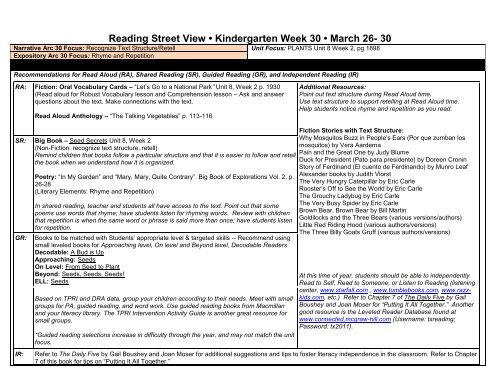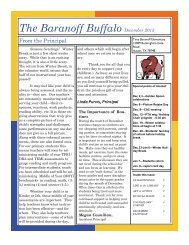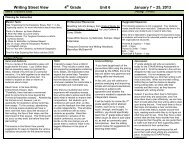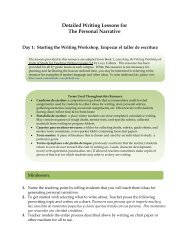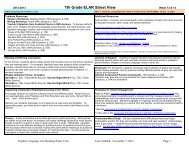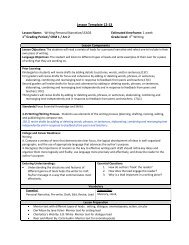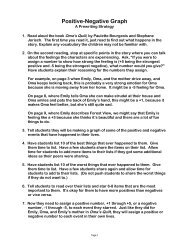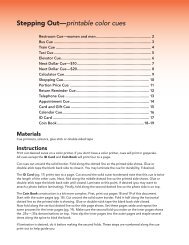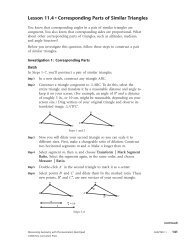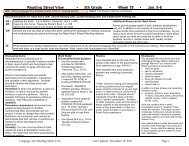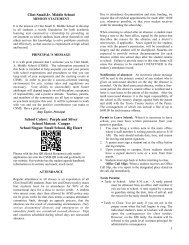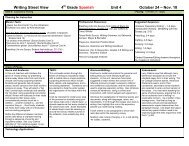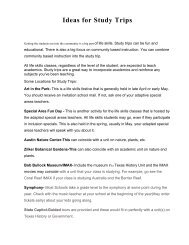Reading Street View • Kindergarten Week 30 • March 26- 30
Reading Street View • Kindergarten Week 30 • March 26- 30
Reading Street View • Kindergarten Week 30 • March 26- 30
- No tags were found...
You also want an ePaper? Increase the reach of your titles
YUMPU automatically turns print PDFs into web optimized ePapers that Google loves.
<strong>Reading</strong> <strong>Street</strong> <strong>View</strong> • <strong>Kindergarten</strong> <strong>Week</strong> <strong>30</strong> • <strong>March</strong> <strong>26</strong>- <strong>30</strong>Narrative Arc <strong>30</strong> Focus: Recognize Text Structure/Retell Unit Focus: PLANTS Unit 8 <strong>Week</strong> 2, pg 1898Expository Arc <strong>30</strong> Focus: Rhyme and RepetitionRecommendations for Read Aloud (RA), Shared <strong>Reading</strong> (SR), Guided <strong>Reading</strong> (GR), and Independent <strong>Reading</strong> (IR)RA: Fiction: Oral Vocabulary Cards – “Let’s Go to a National Park” Unit 8, <strong>Week</strong> 2 p. 19<strong>30</strong>(Read aloud for Robust Vocabulary lesson and Comprehension lesson – Ask and answerquestions about the text. Make connections with the text.Read Aloud Anthology – “The Talking Vegetables” p. 113-116Additional Resources:Point out text structure during Read Aloud time.Use text structure to support retelling at Read Aloud time.Help students notice rhyme and repetition as you read.SR: Big Book – Seed Secrets Unit 8, <strong>Week</strong> 2(Non-Fiction: recognize text structure, retell)Remind children that books follow a particular structure and that it is easier to follow and retellthe book when we understand how it is organized.GR:IR:Poetry: “In My Garden” and “Mary, Mary, Quite Contrary” Big Book of Explorations Vol. 2, p.<strong>26</strong>-28(Literary Elements: Rhyme and Repetition)In shared reading, teacher and students all have access to the text. Point out that somepoems use words that rhyme; have students listen for rhyming words. Review with childrenthat repetition is when the same word or phrase is said more than once; have students listenfor repetition.Books to be matched with Students’ appropriate level & targeted skills -- Recommend usingsmall leveled books for Approaching level, On level and Beyond level, Decodable ReadersDecodable: A Bud is UpApproaching: SeedsOn Level: From Seed to PlantBeyond: Seeds, Seeds, Seeds!ELL: SeedsBased on TPRI and DRA data, group your children according to their needs. Meet with smallgroups for PA, guided reading, and word work. Use guided reading books from Macmillanand your literacy library. The TPRI Intervention Activity Guide is another great resource forsmall groups.*Guided reading selections increase in difficulty through the year, and may not match the unitfocus.Fiction Stories with Text Structure:Why Mosquitos Buzz in People’s Ears (Por que zumban losmosquitos) by Vera AardemaPain and the Great One by Judy BlumeDuck for President (Pato para presidente) by Doreen CroninStory of Ferdinand (El cuento de Ferdinando) by Munro LeafAlexander books by Judith ViorstThe Very Hungry Caterpillar by Eric CarleRooster’s Off to See the World by Eric CarleThe Grouchy Ladybug by Eric CarleThe Very Busy Spider by Eric CarleBrown Bear, Brown Bear by Bill MartinGoldilocks and the Three Bears (various versions/authors)Little Red Riding Hood (various authors/versions)The Three Billy Goats Gruff (various authors/versions)At this time of year, students should be able to independentlyRead to Self, Read to Someone, or Listen to <strong>Reading</strong> (listeningcenter, www.starfall.com , www.tumblebooks.com, www.razzkids.com,etc.) Refer to Chapter 7 of The Daily Five by GailBoushey and Joan Moser for “Putting It All Together.” Anothergood resource is the Leveled Reader Database found atwww.connected.mcgraw-hill.com (Username: txreading;Password: tx2011).Refer to The Daily Five by Gail Boushey and Joan Moser for additional suggestions and tips to foster literacy independence in the classroom. Refer to Chapter7 of this book for tips on “Putting It All Together.”
Discussing Genre (Poetry):In kindergarten, children love poetry inthe form of songs, finger plays, andMother Goose Nursery Rhymes. If thechildren have access to these poems inprinted form in the classroom, they canuse their knowledge of familiar poemsand songs to build literacy skills. Thepoems may be presented in a variety ofways. Large-print poems to read witha pointer Poetry cards mounted ontagboard Small books of poems A class book of poems Individual copies of poems(Poetry Journals/Folders) Jig-saw poems for children toput together and read Copies of poems to read andPhonemic Awareness/Phonics/Word Study:PA: Phoneme Isolation Unit 8, p. 1913,1935Phoneme Blending Unit 8, p.19<strong>26</strong>Phoneme Deletion Unit 8, p. 1944,1951Poems: Funny Pup! Teaching Chart53, p. 1912, 1914Grow a Garden p. 1919, 1941 IdentifyRhythmLittle Boy Blue p. 1931 IdentifyAlliterationIn My Garden, Mary Mary QuiteContrary, p. 1933Phonics: Sound SpellingTeaching Chart 53, Introduce /u/ uReview /k/ k, /l/ lWord Building Cards – a, b, c, d, e, f, h,i, k, m, n, o, p, r, s, t, uillustrateBuilding Comprehension (Narrative- recognize story structure): “The TalkingVegetables”Have children listen to find out the lesson Spider learns. Have them listen for whathappens at the beginning, middle, and end of the story. Use Think Alouds duringthe first reading of the story. Notes about the genre and cultural perspective maybe used during subsequent readings.Respond to Literature:What did Spider say when his neighbors asked for help?What do you think would have happened if Spider had acted differently?How does this folktale relate to something in your experience? .Building Comprehension (Expository):Big Book – Seed Secrets Unit 8, <strong>Week</strong> 2(recognize text structure, retell)Preview and Predict: Display the cover and read the title as you track the print.What do you think we will learn from this text? Remind children that observinghow a book is organized can help them to understand it. This book is organizedby the different ways that seeds travel.Suggestions for Pre-Teaching/ELPS:Before reading to, with or next to children there should always be some kind ofintroduction. Introductions will vary with each type of reading: when makingpredictions you may not want to introduce the entire story.Preparation for Assessment: Assessments should be appropriate Anectodal notesFluency:Fluency is modeled with letter namingfluency, high frequency word fluency(automaticity) and teacher modelingfluency during read aloud time. Modelwhat good readers sound like withintonation and expression. Familiarpoems introduced whole group duringshared reading should be placed inpoetry folders.High Frequency Word Cards:New words: here, wasReview words: and, what, little, said.Vocabulary:Resources:Oral LanguageTheme: Seeds and PlantsTeaching Chart #52 p. 1910Treasures Unit 8, pp. 1918, 19<strong>30</strong>, 1940Vocabulary: necessary, seeds, moist,observe, graduallyUse Robust Vocabulary Lessonroutines from TE.Robust Vocabulary LessonsTreasures Unit 8, pp. 19<strong>30</strong>Oral Vocabulary Cards “Let’s Go to aNational Park”Vocabulary: necessary, seeds, moist,observe, graduallyCritical Questions (Fiction):1. Ask children to share their favorite part of the story.2. Which parts of the story were repeated again and again?3. What happened at the beginning of the story? In the middle? At the end?4. Were you surprised by how the story ended? Why or why not?5. Do you think the main character deserved what he got at the end?6. How does this folktale remind you of another one we’ve read? (Little Red Hen)7. What does this story teach you about working together?Critical Questions (Expository):1. Were your predictions about this book correct? Tell why or why not.2. How did you know?3. Which words were repeated again and again?4. How did the author organize this book?5. What new information did you learn from this book?Suggestions for Interventions:Use the TPRI Interventions Guide and guided reading lessons during small grouptime.Anchors of Support:Word Wall
ObservationsWord Winner charts with vocabulary words from the week TPRIWord Banks that go along with the UnitTeacher Tips: See Daily 5 for tips on Self Directed Learning - Independent <strong>Reading</strong>, Buddy <strong>Reading</strong>, Listening to <strong>Reading</strong>Narrative Arc <strong>30</strong> Focus: Story Structure/Draw ConclusionsExpository Arc <strong>30</strong> Focus: Text Feature - Using Photographs<strong>Reading</strong> <strong>Street</strong> <strong>View</strong> • <strong>Kindergarten</strong> <strong>Week</strong> 31 • April 2-5Unit Focus: Unit 8 <strong>Week</strong> 3, pg1986Recommendations for Read Aloud (RA), Shared <strong>Reading</strong> (SR), Guided <strong>Reading</strong> (GR), and Independent <strong>Reading</strong> (IR)RA: Fiction: Oral Vocabulary Cards – “Anansi and the Melon” Unit 8, <strong>Week</strong> 3 p. 2014(Read aloud for Robust Vocabulary lesson and Comprehension lesson – Make predictionsbased on cover, title, and illustrations. Confirm as you read text.)Read Aloud Anthology – “The Rabbit and the Elephant” p. 117Be sure to stop and ask questions appropriate for children at this time of year, There areBefore, During, and After Think Aloud suggestions in the anthology.Trade Book – Sunflower House Unit 8(Fiction: recognize story structure, make and confirm predictions)Remind Students that they can use a book’s structure, such as repeated patterns, to figureout what will come next as they read and listen. Refer to illustrations to check to see if thepredictions they make are correct.SR: Non- Fiction: “How Does a Garden Grow?” Big Book of Explorations Vol. 2, p. 29-32(text feature – use photographs)GR:In shared reading, teacher and students all have access to the text. Point out photographsand map in text. Photographs tell the reader that the book is about real people, places, orthings. Identify places where signs and symbols are used (parks, streets, maps).Books to be matched with Students’ appropriate level & targeted skills -- Recommend usingsmall leveled books for Approaching level, On level and Beyond level, Decodable Readers.Additional leveled books may also be available in your school’s Literacy Library.Decodable: Pick ItApproaching: It Was Here!On Level: I Like This FlowerBeyond: Kim’s GardenELL: I Will Sit HereAdditional Resources:Point out story structure during Read Aloud time.Make and confirm predictions as you Read Aloud.Fiction Stories that focus on story structure and plants:A Tree is Nice by Berger, M.Anna's Garden Songs by Steele, M.Q.Discovering Trees by Brandt, K.Eating the Alphabet by Ehlert, L.From Seed to Plant by Gibbons, G.Growing Vegetable Soup by Ehlert, L.Here a Plant, There a Plant... by Quackenbush, R.In the Tall, Tall Grass by Fleming, D.Jack and the Beanstalk by Pearson, S.Lunch by Fleming, D.Over in the Meadow by Keats, E.Planting a Rainbow by Ehlert, L.Plants that Never Bloom by Heller, R.Reason for a Flower by Heller, R.Seed Song by Saksie, J.Stone Soup by Brown, M.Tiny Seed by Carle, E.Tree: A First Discovery Book by ScholasticLook for these books in your school library or check onhttp://ibistro/uhtbin/cgisirsi/x/0/0/49.Think Aloud: Sentence stems to guide your discussions(from Read Aloud Anthology Copying Masters)I wonder…I made a connection with…I was able to picture in my mind…I figured it out because…I noticed the author used...I thought ___ was important in this text because…This was mostly about…When I read ____, I had to re-read, read back, read on…
IR:Students have individual book bags or boxes. These contain books from many different sources; guided reading books, picture books, high interest books fromthe school library, read aloud books from the classroom, poetry folders or alphabet charts. Be sure to switch books out, allowing children to “shop” for newbooks regularly. Stamina at this point in the school year should be at least 15 minutes of actual focused independent reading.Discussing Genre (Fiction/Folktale):Remind students that a folktale is astory that has been told and retold formany years. Point out that thecharacters in a folktale are oftenanimals that talk and act like people,especially folktales from Africa, like thisweek’s folktale. Some folktales follow apattern of actions and words such as inthe Little Red Hen.Phonemic Awareness/Phonics/Word Study:PA: Phonemic Isolation Unit 8, p. 1997Phoneme Segmentation Unit 8, p.2010, 2035Phoneme Deletion Unit 8, p. 2019Phoneme Blending Unit 8, p. 2028Poems:Kick the Little Ball-Teaching Chart 55,p. 1996, 1998I’m a Little Acorn Brownp.2003-identify rhymeLovely Little Cherry Tree p.2015-identify rhymePhonics: Sound SpellingTeaching Chart 55,Review /k/ k, /u/ u, /l/ l, /b/ bWord Building Cards - /k/ k, /u/ u, /l/ l,/b/ b, /o/ o, /t/ tBuilding Comprehension (Fiction/Folktale): “The Rabbit and the Elephant”Before reading, explain that this folktale is from Ghana, a country in Africa. ManyAfrican folktales include animals that talk and act human. Invite children to recallother folktales that have had this characteristic.Have children listen to identify the problem of the main character, Rabbit andElephant, and how it is solved.Respond to Literature:Ask children to retell the folktale by acting it out. Then ask: How did Elephantchange from the beginning of the story to the end? How is this folktale like thefolktale “ The Talking Vegetables”? What does the author teach you about helpingothers?Building Comprehension (Expository):“How Does a Garden Grow?” Big Book of Explorations Vol. 2, p. 29-32(text feature – use photographs)Preview and Predict: Display the first page and read the title as you track the print.Point to the tomato on p29. Is it a flower or vegetable? What will this selection beabout? Which kind of garden will we learn about?Text features: Photos tell the reader that the book is about real people or things.Suggestions for Pre-Teaching/ELPS:Use gestures for beginning ELL learners. Act out planting, watering, and pickingtomatoes as you say a sentence about what you are doing. Have children repeatyour actions and your sentences. For intermediate, use illustrations. ForAdvanced/Advanced High, work on understanding sequence of story events.Preparation for Assessment: Assessments should be appropriate Anectodal notesFluency:Fluency at this time of the year ismodeled with letter naming fluency,high frequency word fluency andteacher modeling fluency during readaloud time. Model what good readerssound like with intonation andexpression. Familiar poems introducedwhole group during shared readingshould be placed in poetry folders.High Frequency Word Cards:New words: little, said, here, wasReview words: and, what.Vocabulary:Resources:Oral LanguageTheme: What’s in My Garden?Teaching Chart 54 , p. 1994Treasures Unit 8, pp. 1994, 2002, 2014,2024, 2032Vocabulary: arrange, basic, garden,senses, tendUse Robust Vocabulary Lessonroutines from TE.Robust Vocabulary LessonsOral Vocaburary Cards –“Anansi and the Melon” Unit 8,<strong>Week</strong> 3 p. 2014Vocabulary: arrange, basic, garden,senses, tendCritical Questions (Fiction):1. Ask children to share their favorite part of the story.2. Were you surprised by how the story ended? Why or why not?3. What clues did you use to base your predictions?4. What clues did you use to confirm your predictions?5. Can you think of another folktale that we have read? Compare that fableto the folktale we read today.6. Have you had an experience similar to the characters? How did you feel?7. What is the moral of the story? What lesson did we learn?8. What motivated the character to behave the way s/he did?Critical Questions (Expository):1. What text feature does the author use to tell us information?2. Were your predictions about this selection correct? Tell why or why not.3. How did you know?4. What things in the book have you seen in your neighborhood?Suggestions for Interventions:Grouping students based on like needs is the next step for small group instructionand intervention. Students who still have needs can be pulled for just a quick 10minute segmenting lesson with 3 or 4 students.Anchors of Support:Word Wall
ObservationsWord Winner charts with vocabulary words from the week TPRIWord BanksTeacher Tips: See Daily 5 for tips on Self Directed Learning - Independent <strong>Reading</strong>, Buddy <strong>Reading</strong>.<strong>Reading</strong> <strong>Street</strong> <strong>View</strong> • <strong>Kindergarten</strong> <strong>Week</strong> 32 • April 10-13Narrative Arc 32 Focus: Ask Questions Unit Focus: Unit 9 AMAZING CREATURES <strong>Week</strong> 1, pg 2074Expository Arc 32 Focus: Classify and CompareRecommendations for Read Aloud (RA), Shared <strong>Reading</strong> (SR), Guided <strong>Reading</strong> (GR), and Independent <strong>Reading</strong> (IR)RA: Fiction: Oral Vocabulary Cards – “Insect Hide and Seek” Unit 9, <strong>Week</strong> 1 p. 2106(Read aloud for Robust Vocabulary lesson and Comprehension lesson – Ask and answerquestions about insects. Classify and compare insects.)Additional Resources:Ask questions and discuss as you read aloud.Stop to classify and compare when appropriate.Read Aloud Anthology – “The Elephants and the Bees” p. 122-127<strong>Reading</strong> aloud is seen as the single most influential factor in your children’s success inlearning to read. Additionally, reading aloud improves listening skills, builds vocabulary, aidsreading comprehension, and has a positive impact on students’ attitudes towards reading,SR: Big Book – Beetles Unit 9, <strong>Week</strong> 1(classify and compare)Remind children that many kinds of things can be grouped together into categories. Childrenshould ask themselves about the different groups, or categories, of beetles as the book isread.GR:Narrative (Fable): “The Ant and the Grasshopper” Big Book of Explorations Vol. 2, p. 33-38(ask questions)A fable is a short story that is meant to teach a lesson. Ask children to recall what they knowabout Aesop fables. Remind children that readers often stop to ask themselves questions toclarify and better comprehend a story.According to Regie Routman, Shared <strong>Reading</strong> is one way of immersing students in rich,literary-level language without worrying about grade level or reading performance. For youngchildren who have limited exposure to the language of storybooks, shared reading anddiscussion of stories provide a framework for literature and language.Books to be matched with Students’ appropriate level & targeted skills -- Recommend usingsmall leveled books for Approaching level, On level and Beyond level, Decodable ReadersDecodable: Bug in a WebApproaching: BugsOn Level: InsectsBeyond: About InsectsELL: The InsectsFiction Stories that focus on classifying:Choose texts that support classifying words and ideas intogroups. Classifying is a very early skill to help young readersbegin to understand main idea.From Head to Toe by Eric Carle (body parts)The True Story of the Three Little Pigs by Jon Scieszka (houses)The Three Little Pigs by various authors (houses)Patrick’s Dinosaurs by Carlson (dinosaurs)Warthogs Paint by Pamela Duncan Edwards (colors)Feathers for Lunch by Lois Ehlert (birds)Growing Vegetable Soup by Lois Ehlert (vegetables)Planting a Rainbow by Lois Ehlert (flowers)Brown Bear, Brown Bear, What Do You See? By Bill Martin (sight)Panda Bear, Panda Bear, What Do You See? By Bill Martin (sight)Polar Bear, Polar Bear, What Do You Hear? By Bill Martin (sound)The Button Box by Margarette S. Reid (buttons)Fiction Stories that focus on comparison:Miss Nelson is Missing (Ila Senorita Nelson ha desaparecido!)by Harry Allard (compare teachers)City Mouse-Country Mouse by various authors (compare cityand country)Blueberries for Sal by Robert McCloskey (compare cub and girl)The Biggest Bear by Lynd Ward (compare bears with above)Mufaro’s Beautiful Daughters by John Steptoe / Cinderella byMarcia Brown/ Bubba the Cowboy Prince by H. Ketterman(compare fairy tales)The Stinky Cheese Man by Jon Scieszka (compare with thebetter known fairy tales)Lon Po Po by Ed Young and Little Red Riding Hood by Sam
*Guided reading selections increase in difficulty through the year, and may not match the unitfocus.McBratneyThe Velveteen Rabbit by Margery Williams and Alexander andthe Wind-up Mouse by Leo Lionni (compare toys)IR:Refer to The Daily Five by Gail Boushey and Joan Moser for additional suggestions and tips to foster literacy independence in the classroom. Refer to Chapter7 of this book for tips on “Putting It All Together.”Discussing Genre (Expository):Before reading non-fiction texts,students brainstorm what they alreadyknow about the subject, predictpossibilities, and raise questions aboutwhat they want to find out. Afterreading, discuss the following: Did we find the answers to ourquestions? What questions do we still needto find out about? What was the most surprisingor interesting thing youlearned?What have you learned byreading this selection that youdidn’t know before?Teachers add their own questions tothese basic questions. (R. Routman)Phonemic Awareness/Phonics/Word Study:PA: Phonemic Isolation Unit 9,2089, 2111Phoneme Blending Unit 9, p. 2102,2120Phoneme Segmentation Unit 9, p.2127Poems: The Ants Go <strong>March</strong>ingTeaching Chart 56, p. 2086Walk, Waddle, and Wiggle Unit 9,p.2088, 2090, 2112Bees Unit 9 p. 2095, 2117 – Listen forRhymeItsy Bitsy Insect Unit 9 p. 2107 – Listenfor RhymePhonics:Teaching Chart 57, p.2090Intro /g/ g, /w/, w Review /k/ k, /u/ uWord Building Cards – m,a,s,t,p I,n,c,o,f,h,d,r,e,b,l,k,u,gBuilding Comprehension Narrative (Fable): “The Elephants and the Bees”Read Aloud Anthology p. 122-127 (ask questions)Tell children that some folktales were created to offer an interesting explanation ofhow things came to be. This folktale offers a make-believe answer to howelephants got their long trunks and why some bees live in hollow trees.Respond to Literature:Ask children to listen carefully to learn how the elephants and bees help eachother in this fable. Stop occasionally so that children can predict what will happennext. Remind children that a good way to understand a book is to ask themselvesquestions about it as they listen and read. Use the Think Alouds (provided inanthology) to model asking/answering questions.Building Comprehension (Expository):Big Book – Beetles Unit 9, <strong>Week</strong> 1(classify and compare)Display the cover and read the title as you track the print. What do you think wewill learn from this text? Remind children that many things can be groupedtogether into categories. Tell children to ask themselves questions about thedifferent categories of beetles as they listen.Suggestions for Pre-Teaching//ELPS:Before reading to, with or next to children there should always be some kind ofintroduction. Introductions will vary with each type of reading: when makingFluency:Fluency is modeled with letter namingfluency, high frequency word fluency(automaticity) and teacher modelingfluency during read aloud time. Modelwhat good readers sound like withintonation and expression. Familiarpoems introduced whole group duringshared reading should be placed inpoetry folders.High Frequency Word Cards:Review words: he, she, is, a, here, was,little, said.Vocabulary:Resources:Oral LanguageTheme: Interesting InsectsTeaching Chart #56 p. 2086, TreasuresUnit 9, pp. 2086, 2094, 2106, 2116,2124Vocabulary: annoy, flutter, distinctive,insect, interestingUse Robust Vocabulary Lessonroutines from TE.Robust Vocabulary LessonsTreasures Unit 9, pp. 2106Oral Vocabulary Cards “Insect Hide andSeek”Vocabulary: annoy, flutter, distinctive,insect, interestingCritical Questions (Fiction):1. Ask children to share their favorite part of the story.2. Do you think this story really happened? How do you know?3. What questions did you think of as we read the story?4. Does this story tell the real reason why elephants have trunks? Whyor why not?5. Why do people enjoy listening to folktales like this one?6. Why do you think the author wrote this story?7. Can you think of another fable that we have read? Compare that fableto the fable we read today.Critical Questions (Expository):1. Were you predictions about this book correct? Tell why or why not.2. How did you know?3. What true information did you learn from this non-fiction book?4. How does the author use classification to give us information?5. What questions did you ask yourself as we read? How did you find theanswers to your questions?Suggestions for Interventions:Grouping students based on like needs is necessary for small group instructionand intervention. Use DRA and/or TPRI data to help group students. Other
IR:Students have individual book bags or boxes. These contain books from many different sources; guided reading books, picture books, high interest books fromthe school library, read aloud books from the classroom, poetry folders or alphabet charts. Be sure to switch books out, allowing children to “shop” for newbooks regularly; otherwise, children become restless with same books week after week.Discussing Genre (Expository):(Big Book-Fish Faces)Remind students that expository textgives information about real things.Ask: Is this something that could reallyhappen? Discuss reading for readingexpository text. Remind children that agood way to understand a book is toask themselves questions about it asthey listen and read. Tell children thatthey can learn about things from a bookby looking at the details to comparethem with each other.Objectives:Ask questionsCompare and contrastRespond to a bookRetell a bookDevelop fluencyPhonemic Awareness/Phonics/Word Study:PA:Phoneme Isolation Unit 9, p. 2173,2195Phoneme Blending Unit 9 p. 2186Phoneme Addition Unit 9 p. 2204, 2211Poems: Fix and Mix Veggie Soup-Teaching Chart 59, p. 2172, 2174Five Little Fishes p.2179-identify rhymeDow by the Bay p.2191-identify rhymePhonics: Sound Spelling TeachingChart 25,Introduce /x/ xReview /t/ t, /g/ g, /b/ b,Word Building Cards -/a/ a, /x/ x, /m/ mHelpful Website: http://www.fcrr.org/Building Comprehension (Fiction): “The Fisherman and His Wife” p. 128-132Tell children that “The Fisherman and His Wife” is a fairy tale. Fairy tales havemake believe elements such as magic and talking animals. This fairy tale is fromGermany and is about a magical fish.Respond to Literature:Ask children to draw a picture of each wish that the wife asked in sequence. Invitethem to act it out.Building Comprehension (Expository):“Sea Animals” “I Don’t Suppose” Big Book of Explorations Unit 9, p. 39-40(literary element- rhyme)Explain that these selections are rhyming poems. Remind children that poetry is adifferent form of writing. Poems use rhyme, rhythm, and language to say things inspecial ways.Suggestions for Pre-Teaching/ELPS:As you read books, make meaning clear by pointing to pictures, demonstratingword meanings, paraphrasing text, and asking children questions.Preparation for Assessment: Assessments should be appropriate Anecdotal notesFluency:Model what good readers sound likewith intonation and expression. Familiarpoems introduced whole group duringshared reading should be placed inpoetry folders.High Frequency Word Cards:has, lookReview words: has, look, he she, here,was.Vocabulary:Resources:Oral LanguageTheme: Amazing OceanTeaching Chart 24, p.Treasures Unit 9, pp. 2170, 2178, 2190,2200, 2208Vocabulary: amazing, deep, invite,ocean, reasonUse Robust Vocabulary Lessonroutines from TE.Robust Vocabulary LessonsTreasures Unit 3, pp. 2190Oral Vocabulary Cards “When WaterCame to Visit”Vocabulary: amazing, deep, invite,ocean, reasonCritical Questions (Fiction):1. How would you describe the characters?2. Have you had an experience similar to the character’s? How did you feel?3. What parts of the story could be real?4. What parts of the story are make-believe?5. What might you learn from this fairy tale?Critical Questions (Expository):1. What are the selections mainly about?2. How are the two selections alike? Different?Suggestions for Interventions:After monitoring progress of your intervention students, it is time to switch thegroups around based on student needs. If students are not making progress firstchange your instruction, next consult another teacher on your campus. Hopefullythis will make a difference. Monitor your children carefully.Anchors of Support:Word Wall
ObservationsWord Winner charts with vocabulary words from the week TPRIWord Bank of Family Words – mother, father, aunt, uncle, cousin, sister, etc.Teacher Tips: See Daily 5 for tips on Self Directed Learning - Independent <strong>Reading</strong>, Buddy <strong>Reading</strong>.<strong>Reading</strong> <strong>Street</strong> <strong>View</strong> • <strong>Kindergarten</strong> <strong>Week</strong> 34 • April 23-27Narrative Arc 34 Focus: Ask Questions/Distinguish Between Fantasy and Reality Unit Focus: AMAZING CREATURES Unit 9 <strong>Week</strong> 3, pg 2242Expository Arc 34 Focus: Using Diagrams and LabelsRecommendations for Read Aloud (RA), Shared <strong>Reading</strong> (SR), Guided <strong>Reading</strong> (GR), and Independent <strong>Reading</strong> (IR)RA: Fiction: Oral Vocabulary Cards – “Powerful Plant-Eating Dinosaurs” Unit 9, <strong>Week</strong> 3 p. 2274(Read aloud for Robust Vocabulary lesson and Comprehension lesson – Ask and answerquestions. Distinguish between fantasy and reality.)Read Aloud Anthology – “Tyler’s Trip to the Library” p. 133-137Trade Book – If the Dinosaurs Came Back Unit 9 p. 2255(Fiction: ask questions, distinguish between fantasy and reality)Tell students that good readers ask themselves questions about stories as they listen andread. Explain to children that some stories are fantasy, or make-believe, and tell things thatcannot happen.SR: Expository (Non- Fiction): “TIME FOR KIDS: Feet First!” Big Book of Explorations Vol.2, p.41-44(text features – diagrams and labels)GR:In shared reading, teacher and students all have access to the text. Point out labels used innon – fiction text. Tell students that a diagram is a drawing that shows all the parts ofsomething. Discuss the diagram of the dinosaur on page 44.Decodable: Pat and the VetApproaching: Look at the DogOn Level: Big BenBeyond: Paul Bunyan and the Blue OxELL: Big DogAdditional Resources:Ask questions and discuss during Read Aloud time.Discuss fantasy/reality as you read.Point out labels and diagrams as appropriate.Fiction Stories with Fantasy/Reality:Stone Soup (Sopa de pierdas) by Marcia BrownWe’re Going on a Bear Hunt by Michael RosenSylvester and the Magic Pebble (Silvestre y la piedrecitamagica) by William SteigMufaro’s Beautiful Daughters (Las bellas hijas de Mufaro) by J.SteptoeThere Was an Old Woman Who Swallowed a Fly by SimmsTabackKing Bidgood’s in the Bathtub by Audrey WoodDay Jimmy’s Boa Ate the Wash by Trina NobleLittle Red Hen (La Gallinita Roja: un viejo cuento) by M ZemachThe Velveteen Rabbit by Margery WilliamsAlexander and the Wind-up Mouse by Leo LionniGoldilocks and the Three Bears (various authors)Little Red Riding Hood (various authors)The Three Little Pigs (various authors)Cinderella (various authors)
By studying different kinds of literary texts, or genres, children learn to appreciate thelanguage and devices authors use in creating them. The study of genres is broader thanguided reading and is perhaps more appropriate for whole-class instruction or small-groupliterature circles. In guided reading, however, children can be introduced to many differentgenres, including informational texts on a variety of topics, “How to” books, mysteries,realistic fiction ,historical fiction, biography, fantasy, traditional folk and fairy tales, sciencefiction, and humor. (Fountas and Pinnell)*Guided reading selections increase in difficulty through the year, and may not match the unitfocus.Fiction Stories that include labeling:Growing Vegetable Soup by Lois EhlertEating the Alphabet by Lois EhlertPlanting a Rainbow by Lois Ehlert<strong>Reading</strong> aloud is seen as the single most influential factor inyoung children’s success in learning to read. Additionally,reading aloud improves listening skills, builds vocabulary, aidsreading comprehension, and has a positive impact on students’attitudes toward reading. Much of what we read aloud may berepeated readings of favorite books and poems. Teachers findwhen they place the read-alouds in the classroom library,children often choose these books to read. – Regie RoutmanIR:Opportunities for students to read self-selected books is an indispensable part of a balanced reading program. In independent reading, students are in chargeof their own reading – by choosing their own books, by doing their own reading, and by taking responsibility to work through the challenges of the text. – R.R.Discussing Genre (Fiction):Fiction Stories allow readers to:Recognize story structureIdentify character and plotRespond to a storyRetell a storyDevelop fluencyModel how readers use acomprehension strategy called “checkfor understanding.” Remember to thinkabout what the author is telling us whenwe read and to stop often to check forunderstanding.Phonemic Awareness/Phonics/Word Study:PA: Phoneme Addition Unit 9, p. 2257,2270Phoneme Segmentation Unit 9, p.2288Phoneme Blending Unit 9, p. 2279,2295Poems: The Ox and Goat - TeachingChart 61, p. 2256, 2258The Stegosaurus - p. 2<strong>26</strong>3, 2285 -Listen for RhymeDinosaur Song –p. 2275 IdentifyRhymePhonics:Teaching Chart 61, Review /ks/ x, /v/ v,/g/ g, /w/ w, /e/ e, /o/ o, /i/ I, /d/ d, /n/, nWord Building Cards – a-p, r-xBuilding Comprehension (Fiction- Ask Questions and Distinguish BetweenFantasy and Reality):Trade Book – If the Dinosaurs Came Back Unit 9 p. 2255Tell children that this story is fiction. It is a fantasy story about something thatcould not really happen. Remind children that good readers ask themselvesquestions about stories as they listen and read.Respond to Literature:Which parts of this story was make-believe (fantasy)? Were any parts of the storyrealistic? What was your favorite thing that the dinosaurs did in the story? Whatother things could dinosaurs do if they really came back? Have students act outor use Retelling Cards to sequence events from the story.Fluency:Fluency is modeled with letter namingfluency, high frequency word fluencyand teacher modeling fluency duringread aloud time. Model what goodreaders sound like with intonation andexpression. Familiar poems and songsintroduced whole group during sharedreading should be placed in poetryfolders for fluency practice. Reviewhigh-frequency words for automaticity.High Frequency Word Cards:Review words: she, he, has, look, here,was.Vocabulary:Resources:Oral LanguageTheme: Animals Now and ThenTeaching Chart 60 p. 2254Treasures Unit 9, pp. 2254, 2<strong>26</strong>2, ,2274, 2284, 2292Vocabulary: fantasy, reality, enormous,gulp, incredibleUse Robust Vocabulary Lessonroutines from TE.Robust Vocabulary LessonsTreasures Unit 9, pp. 2274Oral Vocabulary Cards “Powerful Plant-Eating Dinosaurs”Vocabulary: fantasy, reality, enormous,gulp, incredibleCritical Questions (Fiction):1. Ask children to share their favorite part of the story.2. What questions did you ask yourself as you listened to the story?3. What things in this story could not really happen?4. What is your favorite illustration? Why did you choose it?5. Could you tell what the story was going to be about by looking at thecover? Why or why not? How could you tell?6. What was the phrase you heard over and over again in the story?7. Why did the author include the names of real dinosaurs at the end of thestory?8. How did the author use his imagination when he wrote this story?
Building Comprehension (Expository):“TIME FOR KIDS: Feet First!” Big Book of Explorations Vol.2, p. 41-44(text features – diagrams and labels)Tell children that this selection is expository text, a text that explains or givesinformation. After introducing the title page, ask students to predict what thearticle is about. Point out that labels can help the reader understand theinformation more easily than text. As you read, ask questions and discuss text toclarify information.Text features: Labels help the reader understand the text.Suggestions for Pre-Teaching/ELPS:Before reading to, with or next to children there should always be some kind ofintroduction. Introductions will vary with each type of reading: when makingpredictions you may not want to introduce the entire story.Preparation for Assessment: Assessments should be appropriate Anecdotal notes Observations TPRI, DRATeacher Tips: See Daily 5 for tips on Self Directed Learning - Independent <strong>Reading</strong>, Buddy <strong>Reading</strong>.Critical Questions (Expository):1. What true information did you learn from this non-fiction article?2. Were your predictions about this article correct? Tell why or why not.3. How did you know?4. How does the author use labels to give us information?5. What questions did you ask yourself as we read? How did you findthe answers to your questions?6. What else would you like to learn about this topic? Where could wefind more information about this subject?Suggestions for Interventions:Remember that the needs of your students are constantly changing; therefore,your interventions and small groups are changing as well. Monitor progress andmake changes based on student needs. Use a flexible grouping system.Anchors of Support:Word WallWord Charts with vocabulary words from the weekWord Banks (individual or classroom)<strong>Reading</strong> <strong>Street</strong> <strong>View</strong> • <strong>Kindergarten</strong> <strong>Week</strong> 35 • April <strong>30</strong> - May 4Narrative Arc 35: Monitor Comprehension: Reread/Use Illustrations/Retell Unit Focus: I KNOW A LOT! Unit 10 <strong>Week</strong> 1, pg 2334Expository Arc 35: Text Features/Using PhotographsRecommendations for Read Aloud (RA), Shared <strong>Reading</strong> (SR), Guided <strong>Reading</strong> (GR), and Independent <strong>Reading</strong> (IR)RA: Fiction: Oral Vocabulary Cards – “The Blind Men and the Elephant” Unit 10, <strong>Week</strong> 1 p.2366(Read aloud and reread for Robust Vocabulary lesson and Comprehension lesson. Useillustrations to clarify information. Retell story with/without Oral Vocabulary Cards.)Read Aloud Anthology – “The Knee-High Man” p. 138-141<strong>Reading</strong> aloud is seen as the single most influential factor in your children’s success inlearning to read. Additionally, reading aloud improves listening skills, builds vocabulary, aidsreading comprehension, and has a positive impact on students’ attitudes towards reading.Additional Resources:Use illustrations to retell stories during Read Aloud time.Monitor student comprehension at Read Aloud time.Help students notice photographs as appropriate.Stories for ending the school year:Teeny Tiny Teacher by S. CalmensonChicken Soup with Rice by Maurice SendakSomething is Going to Happen by Charlotte Zolotow
SR: Big Book – What Do You Know! Unit 10, <strong>Week</strong> 1(Fiction: monitor comprehension, reread, retell)Tell children that when they do not understand something, a good approach is to monitor andadjust their comprehension by rereading parts and looking at the illustrations.GR:Expository (Non-Fiction text): “Water Changes” - Big Book of Explorations Vol. 2, p. 45-51(Text Features: Using photographs)Remind children that some expository text gives information using words and photographs.Tell children that sometimes photographs can give information more easily than words can.In shared reading, teacher provides an enlarged text that all children can see (or a small textof which each child has a copy). On refrains and multiple readings, children join in, reading inunison. Materials include large-print charts, big books, individual copies, easel, pointers. –Fountas and PinnellBooks to be matched with Students’ appropriate level & targeted skills -- Recommend usingsmall leveled books for Approaching level, On level and Beyond level, Decodable ReadersDecodable: Jeb is Quick!Approaching: I Am Quick!On Level: Duck QuacksBeyond: The PlayELL: Quack!Teachers will have well-established routines for meeting with Guided <strong>Reading</strong> groups by thistime of year. Based on TPRI and DRA data, children are placed in flexible groups accordingto their needs.Anansi Goes Fishing by Eric KimmelMe on the Map by Joyce SweeneyJulius, Baby of the World (Julius, el reyde la casa) by KevinHenkesSalt His Shoes: Michael Jordan in Pursuit of a Dream by DelorisJordan and Roslyn M. JordanFables by Arnold Lobel (E LOBIf I were in Charge of the World by Judith ViorstOh! The Places You’ll Go by Dr. SeussFollow the Water from Brook to Ocean by Arthur DorrosRemember to re-read class favorites and class-made books!At this time of year, students should be able to independentlyRead to Self, Read to Someone, or Listen to <strong>Reading</strong> (listeningcenter, www.starfall.com , www.tumblebooks.com, www.razzkids.com,etc.) Refer to Chapter 7 of The Daily Five by GailBoushey and Joan Moser for “Putting It All Together.” Anothergood resource is the Leveled Reader Database found atwww.connected.mcgraw-hill.com (Username: txreading;Password: tx2011).IR:*Guided reading selections increase in difficulty through the year, and may not match the unitfocus.Refer to The Daily Five by Gail Boushey and Joan Moser for additional suggestions and tips to foster literacy independence in the classroom. Refer to Chapter7 of this book for tips on “Putting It All Together.”Discussing Genre:By this time of year, the children havehad exposure and conversations aboutmany types of books, including fiction(narrative), non-fiction (expository), fairytales, folk tales, fables, etc. During thelast few weeks of school, children maybe able to sort and classify books in theclassroom. A brief discussion aboutclassification could follow daily ReadAloud times.Phonemic Awareness/Phonics/Word Study:PA: Phoneme Isolation Unit 10, p.2349, 2371Phoneme Blending Unit 10, p.2362Phoneme Substitution Unit 10, p. 2380,2387Poems: It’s Such a Good Feeling -Teaching Chart 62, p. 2346Jack Quacks – Teaching Chart 63,p.2348, 2350See, See! p. 2355, 2377 IdentifyRhymeA-Hunting We Will Go p. 2367 IdentifyRhythmPhonics:Sound SpellingTeaching Chart 63Fluency:Fluency is modeled with letter namingfluency, high frequency word fluency(automaticity) and teacher modelingfluency during read aloud time. Modelwhat good readers sound like withintonation and expression.High Frequency Word Cards:New words: with, myReview words: she, he, has, look, I,play.Vocabulary:Resources:Oral LanguageTheme: Show What You KnowTeaching Chart #62 p. 2346Treasures Unit 10, pp. 2354, 2366,2376, 2384Vocabulary: texture, confused, insist,describe, understandUse Robust Vocabulary Lessonroutines from TE.Robust Vocabulary LessonsTreasures Unit 10, pp. 2366Oral Vocabulary Cards “The Blind Menand the Elephant”
Introduce /j/ j , /kw/ qu Review /v/ v, /w/wWord Building Cards –m,a,s,t,p,i,n,g,l,o,e,b,w,j,q,uBuilding Comprehension (Narrative) - Monitor Comprehension: Reread/UseIllustrations/Retell) Big Book: What Do You Know!Display the cover. Read the title and the name of the author/illustrator as youtrack the print. Ask children if they think this story is fiction or expository. How doyou know? Why might we read both types?Respond to Literature:This story is full of questions and challenges for the children! Stop to answer anddiscuss as you read. Reread and use the illustrations to monitor comprehensionas you go.Building Comprehension Expository (Non-Fiction text): “Water Changes” -Big Book of Explorations Vol. 2, p. 45-51(Text Features: Using photographs)Assess children’s prior knowledge of water by asking them to describe what thegirl on page 45 is doing. Help them understand that she is floating on the water.Ask children where there is water. Have children make predictions about what thisselection will be about based on the title and photographs.Suggestions for Pre-Teaching/ELPS:Before reading to, with or next to children there should always be some kind ofintroduction. Introductions will vary with each selection. When making predictionsyou may not want to introduce the entire story. Pre-teach vocabulary as needed.Preparation for Assessment: Assessments should be appropriate Anecdotal notes Observations TPRIVocabulary: texture, confused, insist,describe, understandCritical Questions (Fiction):8. Ask children to share their favorite part of the story.9. What kinds of animals did you see in this book?10. Were your predictions about this book correct? How do you know?11. How did the author and illustrator make the book funny?12. Which illustrations helped you answer the questions?13. Which illustrations helped you understand what was happening?14. How are the pages of the story alike and different from each other?Critical Questions (Expository):6. Were your predictions about this book correct? Tell why or why not.7. How did you know?8. What new information did you learn from this book?9. How did the photographs help us understand the text?10. What other information would you like to learn about this topic?Suggestions for Interventions: Remember that the needs of your students areconstantly changing; therefore, your interventions and small groups are changingas well. Monitor progress and make changes based on student needs. Use aflexible grouping system.Anchors of Support:Word WallWord Winner charts with vocabulary words from the weekWord Banks that go along with the UnitTeacher Tips: See Daily 5 for tips on Self Directed Learning - Independent <strong>Reading</strong>, Buddy <strong>Reading</strong>, Listening to <strong>Reading</strong><strong>Reading</strong> <strong>Street</strong> <strong>View</strong> • <strong>Kindergarten</strong> <strong>Week</strong> 36 • May 7-11Narrative Arc 36: Monitor Comprehension: Reread/Identify Cause and Effect Unit Focus: I KNOW A LOT! Unit 10 <strong>Week</strong> 2 p. 2420Expository Arc 36: Text Features/Using PhotographsRecommendations for Read Aloud (RA), Shared <strong>Reading</strong> (SR), Guided <strong>Reading</strong> (GR), and Independent <strong>Reading</strong> (IR)RA: Fiction: Oral Vocabulary Cards – “Fun Places” Unit 10, <strong>Week</strong> 2 p. 2450(Read aloud for Robust Vocabulary lesson and Comprehension lesson. Discuss photographsto check comprehension.)Additional Resources:Reread for understanding as needed during Read Aloud time.Identify Cause and Effect as appropriate as you read.Read Aloud Anthology – “Ma Lien and the Magic Brush” p. 142-147 - Use Think Alouds asyou read.Stories that show Cause and Effect:
SR:GR:IR:Big Book (Narrative/Fiction): Warthogs Paint: A Messy Color Book(monitor comprehension by rereading; identify cause and effect) Point out that rereading canhelp readers understand the story. Point out and discuss cause and effect as appropriate.Expository: “Amazing People” Big Book of Explorations, Vol. 2, p. 53-58(text features/using photographs) Remind children that some expository text gives informationusing words and photographs of real people and things. Sometimes photographs can giveinformation more easily than words can.Shared <strong>Reading</strong> is a natural way to teach skills and specific features of print. However,Regie Routman emphasizes that the text should first be read and reread several times purelyfor enjoyment. On a subsequent reading, one or two teaching points can be made.Books to be matched with Students’ appropriate level & targeted skills -- Recommend usingsmall leveled books for Approaching level, On level and Beyond level, Decodable ReadersDecodable: Zip?Approaching: Can You See It?On Level: My Pet and MeBeyond: Art by AnneELL: My Pet*Guided reading selections increase in difficulty through the year, and may not match the unitfocus. Remember that guided reading groups must be flexible, depending on which skillsneed to be practiced with which students at a given time. Use most recent DRA/TPRI data toupdate guided reading groups as needed.The ultimate goal in guided reading is to help children learn how to use independent readingstrategies successfully. Teachers, based on their knowledge of children, possible texts, andthe processes involved in reading and learning to read, make a series of complex decisionsthat influence and mediate literacy for the young children in the group. Guided reading alsoinvolves ongoing observation and assessment that inform the teacher’s interactions withindividuals in the group and help the teacher select appropriate texts. – Fountas and PinnellStone Soup (Sopa de piedras) by Marcia BrownLittle House (la casita) by Virginia BurtonVery Hungry Caterpillar (La oruga muy hambrienta) by EricCarleMillions of Cats by Wanda GagHenny Penny by Paul GaldoneDoorbell Rang (Llaman a la puerta) by Pat HutchinsChicka Chicka Boom Boom by Bill MartinI Know an Old Lady Who Swallowed a Fly (variousauthors/versions)Whose Mouse are You? By Robert KraussCow that went Oink (Vaca que decia oink) by Bernard MostIf You Give a Moose a Muffin (Si le das un panecillo a un alce)by Laura Numeroff (and others in this series)Caps for Sale (Se venden gorras) by E. SlobodkinaNoisy Nora (Nora la revoltosa) by Rosemary WellsLittle Red Hen (La Gallinita Roja: unviejo cuento) variousauthors/versionsFortunately by Remy CharlipTell students that a reading strategy is a technique or processconsciously used by a reader to understand a text. Skilledreaders use strategies every time they read. The strategiesused depend on the text demands. Strategies can be usedbefore, during, and after reading. Modeling strategic thinking isa way to encourage and teach students to think aloud on theirown as they attempt to understand text. Suggestions for ThinkAlouds are provided for each main selection in Texas Treasuresin the Teacher’s Edition. (from Instructional Routine Handbook,Macmillan/McGraw-Hill)The goal of all classroom reading is to develop readers who select and read books independently. <strong>Kindergarten</strong> children will not be silent but will be readingsoftly to themselves or their friends and will often be approximating texts that teachers read to them. During independent reading, children may also choose toread big books that they have encountered in shared reading. The most popular big books are those that children have made themselves through interactivewriting. As children become more proficient as readers, teachers may require them to keep a list of books they’ve read independently. Fountas and Pinnell
Discussing Genre (Folktales):Remind children that folktales arestories that have been told and retoldfor many years. Many cultures aroundthe world have their own folktales. MaLien and the Magic Brush is a folktalefrom China. Chinese folktales havebeen passed on for thousands of years.Some folktales feature magicalcharacters or objects that have specialpowers. The character in this folktalereceives a magical paintbrush from awizard.Phonemic Awareness/Phonics/Word Study:PA: Phonemic Isolation Unit 10, p.2433, 2455Phoneme Blending Unit 10, p. 2446,2464Phoneme Substitution Unit 10, p. 2471Poems:At the Zoo Chart 65, p. 2432, 2434What is the Word? p. 2439, 2461 –Listen for RepetitionCan You Say? p. 2451 – Listen forRepetitionPhonics: Sound SpellingWord Building Cards –Introduce /y/ y, /z/ zReview /q/ q, /u/ u, /j/ jBuilding Comprehension (Fiction/Narrative: Big Book Warthogs Paint: AMessy Color Book(monitor comprehension by rereading; identify cause and effect) Remind childrenthat rereading a page can help when they do not understand something. Remindchildren that sometimes one thing makes another thing happen.Respond to LiteratureSet a purpose for reading by telling the children that they will need to look at theillustrations very carefully to discover clues about why the events happen. Whathappened to create the different colors? Go back and reread as appropriate.Identify and discuss cause/effect. Use Retelling Cards (p.2444).Building Comprehension (Expository): Non- Fiction: “Amazing People” BigBook of Explorations, Vol. 2, p. 53-58(text features/using photographs)Remind children that photographs tell the reader about real people, places, orthings. Sometimes photographs can give information more easily than words.Based on the photos, what do you think this selection will be about?Suggestions for Pre-TeachingBefore reading to children there should always be some kind of introduction.Access children’s prior knowledge about farming. Ask the children to makeinferences from the title and the photographs. Review the concepts of “long ago”and “now.”Fluency:Fluency plays an important role inbecoming a good reader. Goodreaders are fast, efficient problemsolvers who use meaning and syntaxas they quickly and efficiently decodeunfamiliar words. Every day teachersmake time in the schedule for childrento engage in fluent, independentreading of familiar or easy texts. –Fountas and PinnellHigh Frequency Word Cards:New words: me, whereReview words: with, my, has, lookVocabulary:Resources: Oral LanguageTheme: Art All AroundTeaching Chart 64 p. 24<strong>30</strong>, 2438,2450, , 2460Vocabulary: create, imagine,extraordinary, design, decorateRobust Vocabulary LessonsTreasures Unit 10, pp. 2450Oral Vocabulary Cards “Fun Places”Use Robust Vocabulary Lessonroutines from TE.Vocabulary: create, imagine,extraordinary, design, decorateAdd these words to Word Wall withchildren.Critical Questions (Fiction):1. Ask children to share their favorite part of the story.2. Which parts would you like to reread for clarification?3. What caused the characters to decide to paint today? (It’s raining outside.)4. Guide children to summarize the story.5. What cause/effect relationships did you notice in this story?6. What clues did the illustrations give the reader?7. Did the author explain these clues or did the reader need to rely on theillustrations? Use text evidence to explain.Critical Questions (Expository):1. Which photos show things from long ago? How can you tell?2. How do the photos used in this text help us understand the story?3. What true information did you learn from this non-fiction article?4. What else would you like to learn about these amazing people?5. Where could we look to find more information?Suggestions for Interventions:People learn to read by reading and to write by writing. Children who are lowachievers, however, often get fewer chances to read and write. They may begiven plenty of drill and practice but spend little time actually reading stories andinformational material. Drill and practice are especially meaningless to childrenwho do not understand the purposes or the joy of reading and writing. An effectiveintervention will have at-risk children reading and writing daily. (Fountas &Pinnell)Preparation for Assessment: Assessments should be appropriateAnchors of Support: Anectodal notesWord Wall ObservationsWord Winner charts with vocabulary words from the week TPRIWord Banks: winter holiday words, food words, farm words Student work samples (drawings, dictation, journal writing, etc.)Posters with labels (winter holidays, farms, foods)Teacher Tips: See Daily 5 for tips on Self Directed Learning - Independent <strong>Reading</strong>, Buddy <strong>Reading</strong>, Listen to <strong>Reading</strong>
<strong>Reading</strong> <strong>Street</strong> <strong>View</strong> • <strong>Kindergarten</strong> <strong>Week</strong> 37 • May 14-18Narrative Arc 37: Monitor Comprehension/Reread/Identify Setting/Retell Unit Focus: Unit 10 I KNOW A LOT! Unit 10 <strong>Week</strong> 3, pg 2502Expository Arc 37: Text Feature: Using DiagramsRecommendations for Read Aloud (RA), Shared <strong>Reading</strong> (SR), Guided <strong>Reading</strong> (GR), and Independent <strong>Reading</strong> (IR)RA: Fiction: Oral Vocabulary Cards – “Mouse Deer Crosses the River” Unit10, <strong>Week</strong> 3 p. 2534(Read aloud for Robust Vocabulary lesson and Comprehension lesson.Reread to identify setting. Retell with/without Oral Vocabulary Cards.)Additional Resources:Monitor comprehension and reread as appropriate during Read Alouds.Stop to identify setting when appropriate.Stop to discuss diagrams as appropriate.Read Aloud Anthology – “Jack and the Beanstalk” p. 148-155Trade Book – Turtle Splash! Unit 10, <strong>Week</strong> 3 p. 2515(Fiction: Monitor comprehension, reread, identify setting, retell)SR: Expository – “TIME FOR KIDS: Your Five Senses” - Big Book ofExplorations Vol. 2 p. 59-62(Text feature: Using diagrams)Remind children that a diagram is a drawing that shows the parts ofsomething. Sometimes diagrams can explain things better than words.According to Regie Routman, Shared <strong>Reading</strong> is one way of immersingstudents in rich, literary-level language without worrying about grade level orreading performance. For young children who have limited exposure to thelanguage of storybooks, shared reading and discussion of stories provide aframework for literature and language.GR: Books should be matched with Students’ appropriate level & targeted skills.Use small leveled books for Approaching level, On level and Beyond level,Decodable Readers and/or use appropriate leveled books from yourcampus Literacy Library.Decodable: Yes, Tip!Approaching: Count with MeOn Level: Can You Count?Beyond: Learning the RulesELL: Count with Me!Teachers will have well-established routines for meeting with Guided<strong>Reading</strong> groups by this time of year. Based on TPRI and DRA data,children are placed in flexible groups according to their needs.Favorite Fairy Tales:AladdinBeauty and the BeastCinderellaThe Frog PrinceThe Gingerbread ManGoldilocks and the Three BearsHansel and GretelJack and the BeanstalkThe Little MermaidLittle Red Riding HoodPeter PanThe Pied Piper of HamlinPinocchioThe Princess and the PeaPuss in BootsSleeping BeautySnow WhiteThree Billy Goats GruffThree Little PigsThe Ugly DucklingEtc…..Note: There are many versions of these classic stories. Children should beexposed to as many as possible throughout the year! Your librarian can help youlocate the traditional stories, as well as “fractured” fairy tales. It is important thatthe children are very familiar with the “traditional” story before introducing otherversions. This background knowledge will help the children compare and contrastalternate versions of the story.IR:Refer to The Daily Five by Gail Boushey and Joan Moser for additional suggestions and tips to foster literacy independence in the classroom. Refer to Chapter7 of this book for tips on “Putting It All Together.”
Discussing Genre (Fairy Tale):Help children look for the following traitsto begin to identify Fairy Tales: Begins with Once Upon a Time,Once long ago, Long, long agoetc. Story has good / nicecharacters Story has mean / badcharacters Story has magic Events happen in “threes” Story has a problem/solution Good wins / outsmarts bad Ending is "happily ever after"Phonemic Awareness/Phonics/Word Study:PA: Phonemic Isolation Unit 10,2517Phoneme Blending Unit 10, p. 2539Phoneme Segmentation Unit 10,p.25<strong>30</strong>Phoneme Substitution Unit 10, p. 2548,2555Poems: My QuillsTeaching Chart 67, p. 2516, 2518One, Two, Three - Unit 10, p.2523,2545 – Listen for Rhythm/RhymeTo Market, To Market – Unit 10, p. 2535– Listen for RepetitionPhonics:Teaching Chart 67, p.2518Intro /g/ g, /w/, w Review /j/ j, /q/ q, /y/y, /z/ zWord Building Cards – a-z (all)Building Comprehension Narrative (Fairy Tale): “Jack and the Beanstalk”Read Aloud Anthology p. 148-155 (Monitor Comprehension/Reread/IdentifySetting/Retell )Tell children that fairy tales have been passed along by word of mouth forhundreds of years. They are about make-believe characters such as talkinganimals, elves, and giants. This fairy tale originated in England.Respond to Literature: How do Jack and his mother get rich? How do you thinkthe man who gave Jack the beans knew his name? Use the Think Alouds(provided in anthology) to model asking/answering questions.Building Comprehension (Expository):“TIME FOR KIDS: Your Five Senses” - Big Book of Explorations Vol. 2 p. 59-62(Text feature: Using diagrams)Display the cover and read the title as you track the print. What do you think wewill learn from this text? Why do some authors use photographs instead ofdrawings? As we read, watch for a diagram and we will talk about it!Suggestions for Pre-Teaching//ELPS:Before reading to, with or next to children there should always be some kind ofintroduction. Introductions will vary with each type of reading: when makingpredictions you may not want to introduce the entire story. Introductions caninclude activating prior knowledge, pre-teaching key vocabulary words, and settinga purpose for reading.Preparation for Assessment: Assessments should be appropriateAnecdotal notesObservationsTPRI/DRA/Running Records/DIBELSFluency:Fluency is modeled with letter namingfluency, high frequency word fluency(automaticity) and teacher modelingfluency during read aloud time. Modelwhat good readers sound like withintonation and expression. Familiarpoems introduced whole group duringshared reading should be placed inpoetry folders.High Frequency Word Cards:Review words: with, my, me, where, is.Vocabulary:Resources:Oral LanguageTheme: Let’s Count Down!Teaching Chart #66 p. 2514,Treasures Unit 10, pp. 2522, 2534,2544, 2552Vocabulary: splendid, consider, final,curious, exploreUse Robust Vocabulary Lessonroutines from TE.Robust Vocabulary LessonsTreasures Unit 10, pp. 2534Oral Vocabulary Cards “Mouse DeerCrosses the River”Vocabulary: splendid, consider, final,curious, exploreCritical Questions (Fiction):8. Ask children to retell their favorite part of the story.9. Do you think this story really happened? How do you know?10. What was the setting of the story? Reread to confirm.11. How do you know that this story was a fairy tale?12. Why do people enjoy listening to fairy tales like this one?13. Why do you think the author wrote this story?14. Can you think of another fairy tale that we have read?Compare/contrast.Critical Questions (Expository):6. Were you predictions about this book correct? Tell why or why not.7. How did you know?8. What true information did you learn from this non-fiction book?9. How does the author use a diagram to give us information?10. What is the topic, or main idea, of this selection?Suggestions for Interventions:Grouping students based on like needs is necessary for small group instructionand intervention. Use DRA and/or TPRI data to help group students. Otherstudents in the class should be reading to self, with a buddy or listening to reading.Teacher should be keeping a record of progress (progress monitoring) and makingchanges to instruction if children are not progressing.Anchors of Support:Word WallWord Winner charts with vocabulary words from the weekWord Banks
<strong>Reading</strong> <strong>Street</strong> <strong>View</strong> • <strong>Kindergarten</strong> <strong>Week</strong> 38 • May 21-25Narrative Arc 38: Review strategies and abilities of understanding Unit Focus: Review Units 8-10Expository Arc 38: Review elements of the text to increase understandingRecommendations for Read Aloud (RA), Shared <strong>Reading</strong> (SR), Guided <strong>Reading</strong> (GR), and Independent <strong>Reading</strong> (IR)RA: Fiction: Use favorite selections from Units 8-10. Additional Resources:During daily Read Aloud times, select one or two skills topractice and review:SR: Non- Fiction: Select a favorite Big Book from Units 8-10 of Treasures. Re-read favorite Recognize text/story structureselections from the Big Book of Exploration. Make/confirm predictionsGR:In shared reading, teacher provides an enlarged text that all children can see (or a small textof which each child has a copy). On refrains and multiple readings, children join in, reading inunison. Materials include large-print charts, big books, individual copies, easel, pointers. –Fountas and PinnellBooks to be matched with Students’ appropriate level & targeted skills -- Recommend usingsmall leveled books for Approaching level, On level and Beyond level, Decodable ReadersDecodable: Review previously read titles from Units 8-10Approaching: Review previously read titles from Units 8-10On Level: Review previously read titles from Units 8-10Beyond: Review previously read titles from Units 8-10*Guided reading selections increase in difficulty through the year, and may not match the unitfocus. Remember that guided reading groups must be flexible, depending on which skillsneed to be practiced with which students at a given time.The ultimate goal in guided reading is to help children learn how to use independent readingstrategies successfully. Teachers, based on their knowledge of children, possible texts, andthe processes involved in reading and learning to read, make a series of complex decisionsthat influence and mediate literacy for the young children in the group. Guided reading alsoinvolves ongoing observation and assessment that inform the teacher’s interactions withindividuals in the group and help the teacher select appropriate texts. – Fountas and PinnellUse illustrationsIdentify setting/character/plotCompare/contrastAsk questionsClassify/categorizeSequence of eventsMake inferencesGood Fiction Stories: Read Favorite Selections from thissemester.Non-Fiction Stories: Read Favorite Selections from thissemester.Shared reading is highly complementary to the instructionalgoals of guided reading. It begins very early in the kindergartenyear before children can read even a little. In shared reading,emerging readers get a chance to behave like readers andlearn the process. After children begin participating in guidedreading groups, however, shared reading does not stop. Manyof the strategies needed for independent reading of a text canbe taught during shared reading, especially when it is used witha small group rather than the whole class. – Fountas andPinnellIR:The goal of all classroom reading is to develop readers who select and read books independently. <strong>Kindergarten</strong> children will not be silent but will be readingsoftly to themselves or their friends and will often be approximating texts that teachers read to them. During independent reading, children may also choose toread big books that they have encountered in shared reading. The most popular big books are those that children have made themselves through interactivewriting. As children become more proficient as readers, teachers may require them to keep a list of books they’ve read independently. Fountas and Pinnell
Discussing Genre:The goal is for all students to applycomprehension skills and strategieswhen reading or hearing stories. Bythis time of the school year,kindergarten students shouldunderstand the following concepts andbe able to apply them to various texts:Recognize text/story structureMake/confirm predictionsUse illustrationsIdentify setting/character/plotCompare/contrastAsk questionsClassify/categorizeSequence of eventsMake inferencesPhonemic Awareness/Phonics/Word Study:PA: Use daily PA routines that havebeen established in your classroom.Review all previously taught skills. SeePA activities on LA website forsuggestions.Phonics:Review all letters introduced so far.Place Sound Spelling cards in pocketcharts to review words that arecomposed of these familiar letters.Fluency:Fluency is modeled with letter namingfluency, high frequency word fluency(automaticity) and teacher modelingfluency during Read Aloud time. Modelwhat good readers sound like withintonation and expression. Familiarsongs and poems introduced wholegroup during shared reading should beplaced in poetry folders.High Frequency Word Cards:Review all words that have been introducedso far. These words should be displayed onthe Word Wall.Vocabulary:Resources: Review vocabulary wordsthat have been introduced so far.Use Robust Vocabulary Lessonroutines from TE.According to Regie Routman, teacherscan best promote vocabularydevelopment within the context ofliterature when the meaning of the textcan be used to determine wordmeaning. We can guide students touse what they know and what theauthor presents to construct wordmeanings strategically at the conceptlevel.Building Comprehension (Fiction/Folktale): Children will be expected to “showwhat they know” up to this point. Teachers may select a Fiction Read Aloud fromthe Additional Resources list above (or a book of their choice). Use the criticalquestions provided from the previous weeks by modifying them to the text beingpresented. Use this opportunity to review the skills and strategies listed above,noting which individual students may need additional practice and support.Provide re-teach as needed.Building Comprehension (Expository): Non- Fiction: Children will be expectedto “show what they know” up to this point. Teachers may select a Non-FictionRead Aloud from the Additional Resources list above (or a book of their choice).Use the critical questions provided from the previous weeks by modifying them tothe text being presented. Use this opportunity to review the skills and strategieslisted above, noting which individual students may need additional practice andsupport. Provide re-teach as neededSuggestions for Pre-TeachingIt is essential to review skills and strategies for comprehension as well as thevocabulary and phonics skills.Critical Questions (Fiction):1. Ask children to retell their favorite part of the story.2. What happened at the end of the story?3. Were your predictions about this book correct? How do you know?4. Ask the students to identify the setting, characters and conflict.5. Ask the students to compare/contrast this story to another story.6. Were there parts of the story that were repeated?Critical Questions (Expository):1. Were your predictions about the book correct? Tell me why or why not.2. How did you know?3. Where there words that were repeated over and over?4. How did the author organize the book?5. What new information did you learn from this book?6. What else did you learn that you didn’t know before?7. What is something interesting or surprising that you learned?Suggestions for Interventions:Grouping students based on like needs is necessary for small group instructionand intervention. Students in the class should be reading to self, with a buddy orlistening to reading (see websites listed above). Some students may Read Aroundthe Room, Write Around the Room, or do another meaningful, independentactivity.Anchors of Support:Word WallWord Winner charts with vocabulary words from the weekWord Banks: winter holiday words, food words, farm wordsPosters with labels (winter holidays, farms, foods)Preparation for Assessment: Assessments should be appropriate Anecdotal notes Observations TPRI Student work samples (drawings, dictation, journal writing, etc.)Teacher Tips: See Daily 5 for tips on Self Directed Learning - Independent <strong>Reading</strong>, Buddy <strong>Reading</strong>, Listen to <strong>Reading</strong>


